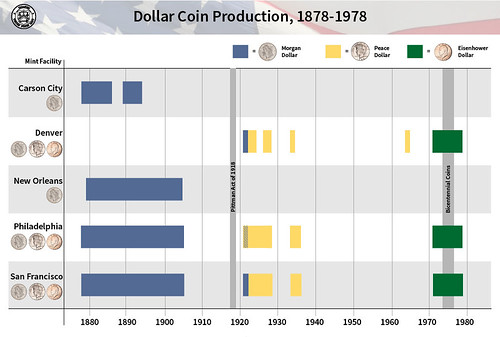
PREV ARTICLE
NEXT ARTICLE
FULL ISSUE
PREV FULL ISSUE
A CENTURY OF SILVER DOLLARSAn article on the U.S. Mint website reviews 100 years of silver dollar coinage. Here's an excerpt. -Editor This year marks the 100th anniversary of completion of coinage of the Morgan Dollar and the 100th anniversary of commencement of coinage of the Peace Dollar. Essentially, it’s the centennial of the transition between minting two of the most famous coins issued by the United States Mint. This year also marks the 50th anniversary of the silver coin that would follow: the Eisenhower Dollar. These three coins, spanning 100 years—from the first Morgan Dollar in 1878 to the final Eisenhower Dollar in 1978—share a connection through history and legacy. Silver Supply and the Morgan Dollar Silver mining in the United States, mainly the Comstock Lode (1859), is the catalyst that gave silver dollar coinage its heyday. Before the nation could truly benefit from this discovery, previous legislation demonetizing silver first had to be overcome. The Bland-Allison Act re-authorized the standard silver dollar to the weight and fineness as stated in the Act of January 18, 1837 (26.73 grams; .900 silver, .100 copper). This new coin would be commonly referred to as the Morgan Dollar, since it was designed by George T. Morgan (who, from 1917-1925, would serve as chief engraver). Adhering to the requirements written in the Coinage Act of April 2, 1792 (1 Stat. 246, 248), the obverse features a profile of Lady Liberty, and the reverse features a heraldic eagle. The first Morgan Dollar coins were struck in 1878 at the Philadelphia Mint. Following some design revisions, they were also struck at San Francisco and Carson City that same year, because of the facilities’ proximity to the silver mines in the western United States. The next year, New Orleans joined in, and, like San Francisco and Philadelphia, would manufacture Morgan Dollars through 1904.
Silver Dollar Production Paused No silver dollar coins were minted in the U.S. from 1905-1920. Since the New Orleans Mint relied on silver coin production for business, this ultimately led to its shutdown as a Mint facility. After World War I, the Pittman Act of 1918 authorized the melting of millions of previously minted silver dollars (primarily Morgan Dollars). However, the Act also required silver to be purchased in order to manufacture new silver coins to replace the melted ones. In order to satisfy the Pittman Act, production of the Morgan Dollar resumed in 1921 at Philadelphia, San Francisco, and – for the first time – Denver. Later that year, the Philadelphia Mint switched production to the Peace Dollar. No special congressional authority was required for the modification in design, since the law permits changing the design of any U.S. coins after 25 years.
The Peace Dollar The design of the Peace Dollar was selected by the Commission of Fine Arts (CFA) from models submitted by a number of prominent sculptors. The CFA chose the work of notable Italian American artist Anthony de Francisci. The obverse design depicts a female head emblematic of Liberty, wearing a tiara of light rays. The reverse design depicts an eagle perched on a mountain top, holding an olive branch in its talons, witnessing the dawn of a new day. The Peace Dollar was struck from 1921-1928, at which point demand for the dollar was low, and the silver supply resulting from the Pittman Act ran out. It was minted one last time prior to World War II, with the passage of what was referred to as the Silver Purchase Act of 1934. The coinage was short-lived, lasting only through 1935. These last Peace Dollars were struck at the Philadelphia, Denver, and San Francisco Mints. It's the infographic that caught my eye in this article. It provides a nice perspective on the overall production. But what's that yellow bar in the 1960s? The elusive 1964-D Peace dollar! -Editor
To read the complete article, see:
Wayne Homren, Editor The Numismatic Bibliomania Society is a non-profit organization promoting numismatic literature. See our web site at coinbooks.org. To submit items for publication in The E-Sylum, write to the Editor at this address: whomren@gmail.com To subscribe go to: https://my.binhost.com/lists/listinfo/esylum All Rights Reserved. NBS Home Page Contact the NBS webmaster 
|

